Designated cultural properties(Town’s cultural properties)
Setouchi Town designated Cultural Assets
A genealogy of the Nishi family
There are no written records concerning the Nishi family, but the tradition is as follows.
Nōetsu, the founder of the Nishi family, was in service at the Kaseda castle (in present-day Minami-Satsuma City) when he fell in love with a daughter of a chief retainer. This was a crime punishable by death, but Nōetsu was treated leniently and was instead banished to the islands. During the late 18th century, the fifth generation Nōetsu moved from Satsukawa on the northeast coast of Kakeroma to Ikomo on the south coast. He was awarded the rank of gōshikaku (rural samurai), and the name "Nishi" was formally bestowed on the family (most Japanese did not have official surnames at this time).
For several generations the Nishi family held power in various official positions such as yohito (the highest official position that islanders were allowed to hold at this time) or kochō (head of a village). Using the excellent port at Ikomo bay as a base, the Nishi family traded goods with the Ryukyu Kingdom, and many of these goods remained within the family. Unfortunately most were destroyed or lost during the war, but what remains is now housed in the Setouchi Municipal Museum, where folding screens, Tanegashima guns, bamboo soldier's helmets, incense burners, vanity cases, mats, ritual artifacts, tin saké cups and so on can be seen.
The Nishi shoin style mansion
The remains of Nishi family’s house can still be seen in Ikomo village. The main building was made in the shoin style (a major style of domestic architecture that was much favoured by the elite at this time). This house has been designated a "tangible cultural asset" of Setouchi Town.
Folklore has it that the Eighth Nōetsu engaged miya-daiku (highly skilled carpenters specializing in temple and shrine construction) from Satsuma in 1836. These carpenters apparently also built houses for the Chin family in Uken and the Kazu family in Yamato.
The wood for the Nishi house was carefully selected from top-grade timber trees growing in the mountains near Kachiura village. Yakushima cedar was used for interior panelling. It took about three years to build the house.
The stone wall in front of the entrance is laid in a style that was also used in many castles. Shaped stones of different sizes are fitted closely together with no gaps, creating a strong, durable wall.
Pictures
Folding creen
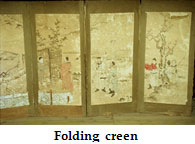 This folding screen was recovered from the Nishi family’s house in Ikomo
village. The screen was put in front of the altar during the Bon Festival,
and is colorfully painted with Chinese-style pictures. The lining of the
folding screen is an 1891 issue of the, "Kagoshima Mainichi Shimbun"
newspaper. This is the oldest newspaper that has been found in Amami.
Dragon-shaped Spout (ryūhi)
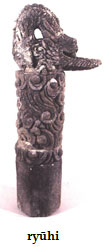 This sculptured spout was taken from the Take family’s house in Sedake village on Kakeroma. According to historical records, most members of the Take family worked as officials in government. In 1826, the Take family was awarded the status of gōshikaku (rural samurai).
The sculpture is made of tuff (a soft volcanic rock), and thus probably would have been carried to Amami from Satsuma. It is 124 cm in height and beautifully carved into the likeness of a dragon rising into the sky.
It is designed so that water enters through a hole at the back, passes up the body of the dragon, and then gushes out of the dragon’s mouth. The sculpture is made in three parts which fit together. The rearing head of the dragon is damaged, and only the dragon’s lower jaw remains.
Handicraft
Chinese medical equipment
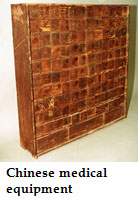 Chinese medical equipment was recovered from the Yanagi family's house in Hyō, on Kakeroma.
Shitei Yanagi probably brought these items back to Amami after training to be a doctor of Chinese medicine in Satsuma. This medicine chest is 83cm (2feet 8inches) tall, and has 123 drawers. It is made of Japanese cedar.
Siam Jar
 This jar was probably carried from Siam (Thailand) to Amami in the 15th or 16th century. The unglazed part is a deep red clay color, and it has four handgrips.
The jar is 60.4cm (1foot 9inches) in height with a mouth 19.5cm (7.7inches) in diameter.
Documents found in the Nishi family’s house.
A lot of historically important items were found in the Nishi family’s
house in Ikomo on Kakeroma. These have been stored in the Setouchi Municipal
Museum.
Ancient Documents
Cadastral Register
This document was found among a group of ancient documents that were gifted
by the Take family to the Setouchi Municipal Museum. As determined by traces
of writing on the cover, the document was probably written in 1728. A land
ledger, this document records such things as the layout, area and yield
of agricultural fields and paddies, together with the names of the owners.
This is the only such land survey document in Setouchi. The document is
26.7cm (10.5inches) in width and 20cm (7.8inches) in length.
Ancient documents from the Ikeda family of Sukomo
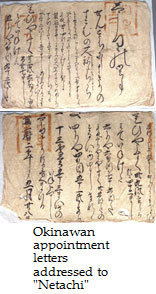 The late Tameyoshi Ikeda came from Sukomo in Kakeroma, but lived in Okayama. He carefully preserved many old documents that had been handed down within his family. For generations the Ikeda family had taken on the role of guji in the noro ritual. In 1996 Ikeda donated the ancient documents, an Edo-period truncheon, a vest, and a crystal ball to the Setouchi Municipal Museum.
Among the documents given to the museum are official Okinawan "notices of appointment", complete with the vermillion seals of the Ryukyu King. These documents illustrate that before Amami became part of the Satsuma Domain in 1609, it was part of the Ryukyu Kingdom.
Material folk culture goods
The noro ritual artifacts of Kanyu
After due consultation, the noro rituals of Kanyu were terminated in 1986 by the village council, because their guji (an important role in the ceremonies) had died. Umachi Kato, who played the roles of both igami and waki noro, presented many noro ritual aritifucts to the community center so that they would not be lost to future generations.
Glass Balls
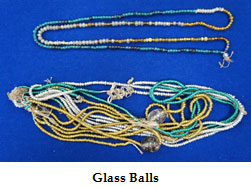 One of these glass balls was kept as part of a necklace and is still in
good condition. The other ball has several rings attached to it in one
place, but whether this is its original form or not is unknown.
Shīshi balls
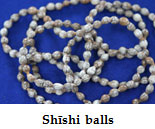 This is a necklace made of dried seeds. It is uncertain whether or not
this was used as part of the noro rituals, but it was among the ritualistic
artifacts donated by Kato.
"Migaki"(Sacred Fan)
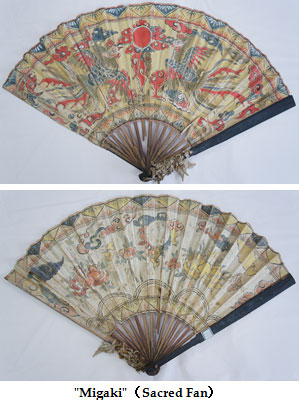 On one side of the fan Chinese phoenixes are painted. On the other side peonies are painted, although their color is believed to have faded.
The fan is 88cm (3 feet) wide and 53cm (1 foot 9 inches) long.
Gong
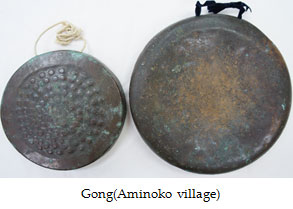 A gong for Noro religious services found in Aminoko called "Kinnobindare". It had been unknown until 1960 when children found accidentally while playing.
[The big one] is 283 mm in diameter and [the small one] is 213 mm in diameter.
Costumes
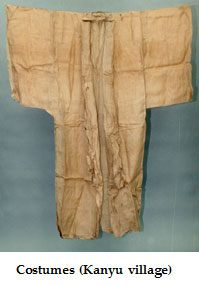 All the costumes received had been kept in good condition. One of them
is made of cotton, another of silk and the last one is probably bashōfu
(cloth made from the fiber of the ito-bashō, a seedy banana, Musa balbisiana
riukiuensis, introduced to the Ryukyus in ancient times).
Intangible Cultural Assets
Andon-de
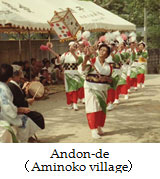 The Andon-de is a folk dance of Aminoko village performed by women. In
the old days there were no rules, and the women danced at lib wearing everyday
clothes. It is said that the dance leader carried a real oil lamp (andon).
Nowadays the Andon-de is usually performed at the harvest festival.The
origin of the Andon-de is said to be that when a local official's daughter
was born a couple of his servants, holding a lantern, spontaneously danced
for joy. A variant of this story has it that the dance celebrated the recovery
from illness of this daughter.The Andon-de dance was designated a Setouchi
Town "intangible cultural asset" on 15 December 1978.
Monuments
Stone Wall Fishing
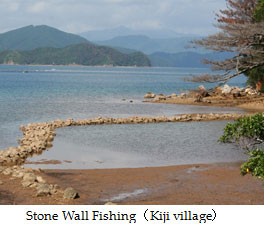
"Stone wall fishing" is an old way of fishing. At high tide fish enter a stone wall enclosure, and then are trapped at the exit when the sea recedes at low tide. This method of fishing was practised in the protected waters of Setouchi, Tatsugo, and Kasari. In the north of Amami the fishing was usually carried out with privately-built stone walls, but in Setouchi the walls and nets were of common village ownership.
Stone wall fishing continued to be practiced for some time after World War II. Kibinago herrings entering the stone wall enclosures were trapped at the exit with nets, bamboo baskets, or even with bare hands. In Kiji and in Oshikaku the broken remains of the stone walls can still be seen.
|


















